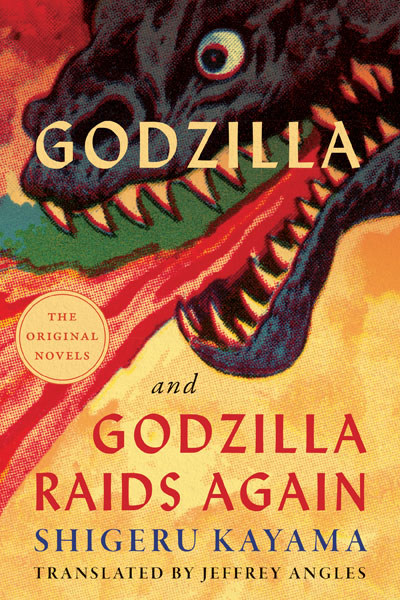Book Review: Godzilla and Godzilla Raids Again by Shigeru Kayama
As you might have noticed from past reviews on this blog, I’m a pretty big fan of Japan’s greatest daikaiju, Godzilla. I’ve seen almost all the movies and TV shows, as well as read the comic book adaptations. But I was unaware that Shigeru Kayama, the scenario creator for the first two movies in the series, had written novelizations of them for young adult readers. But University of Minnesota Press found out, and was able to get the license to have an English translation by Professor Jeffrey Angles published. So here we are.

The novellas roughly follow the same plots as the movies. In “Godzilla”, a series of ships mysteriously disappear, with communication suggesting that an unknown force is sinking them. This turns out to be a giant dinosaur-like creature which is quickly named “Gojira” after a legendary monster the people of Oudo Island have long feared. (While the name “Godzilla” is a bad transliteration, it works well as Gojira is supposed to be godlike in nature.)
Godzilla is highly radioactive, and appears to have been awoken/mutated by hydrogen bomb tests in the area. For reasons known only to itself, Godzilla comes to Japan and rampages through Tokyo, killing thousands. The Self Defense Forces are helpless against it as conventional weaponry will not penetrate the kaiju’s skin.
Brilliant scientist Dr. Serizawa has developed a device known as the Oxygen Destroyer that might be able to destroy Godzilla. And all other marine life within its radius of effect. Realizing that such a creation would immediately be weaponized by militaries, and possibly still having some guilt over his participation in Axis research during World War Two, Serizawa refuses to let this be used.
Finally, the destruction that Godzilla has caused, and its existential threat to Japan, convince Dr. Serizawa to act. But he makes sure to destroy all copies of his research process, and hand-delivers the prototype to Godzilla so that they die together. Paleontologist Professor Yamane warns that if hydrogen bomb testing continues, another Godzilla might be created.
In “Godzilla Raids Again”, sure enough, it’s discovered that there’s a second Godzilla, this time not so far from Osaka. Worse, a second kaiju, Anguirus (a giant mutated ankylosaur) is also on the loose. The two monsters are antagonistic to each other, and fight each time they meet.
This is not a good thing. The titans clash in Osaka, and their battle destroys the city as a byproduct, killing more thousands before Godzilla manages to roast Anguirus to death with his atomic breath.
The military has learned lessons since the first Godzilla, and at the end they are able to bury the second Godzilla under enough ice that even it can’t dig its way out. But the cost is high.
There are some changes as well. The novels are even more direct that Godzilla is a metaphor for the atomic bomb and the horrors of nuclear warfare. The first one also shifts the human protagonist role from Mr. Ogata, the president of the marine salvage company, to his young employee, Shinkichi. Among other things, this eliminates the love triangle subplot from the movie.
It’s pretty obvious that these stories were written for younger readers. The author sometimes addresses the readers directly to explain things more clearly than might be done for adults who would already be expected to know the subject matter. There’s also quite a lot of sound effect words left in when the translator was able to make them work in English. (Godzilla and Anguirus have different sound effects for their roars.)
There’s also extensive translator notes, explaining the creative process that led to the Godzilla movies, the cultural context that made them (especially the first) so impactful, who Mr. Kayama was and what else he’s known for, and the translation choices made. This comes with footnotes and a glossary.
Content note: A lot of people die in these early Godzilla stories, including children and named characters. Mr. Kayama does not shy away from depicting the effect this has on the survivors.
These are exciting stories from the roots of the Godzilla mythos, before all the later additions. While any kaiju fan should find them interesting, they’d be best appreciated by teenage fans of giant monsters. If this volume sells well, UofM Press might be able to get the rights to Mothra, the novel on which that film was based.

